Lean Body Mass Program
Spartanmedicalassociates.com Weight loss medication treatment available separately
- We cannot burn fat in the presence of insulin!
- High insulin levels cause weight gain and obesity!
- What and when we eat is the key to lowering insulin levels!
- This works as a stand alone regimen but combining this plan with optimized hormones will yield superior results!
Weight gain and obesity are associated with a significant increase in chronic, life threatening diseases including diabetes mellitus, hypertension, high cholesterol, heart disease, stroke, sleep apnea, cancer and death. Weight loss is one of the most important interventions one can make to improve longevity, life span and health span.
Obesity in the United States has reached a crisis level over the past 30 years due to our Western diet with a marked increase in processed carbohydrates and refined sugars. The nutrition industry has massively profited at the expense of American’s health and taxpayer dollars spent on treating preventable diseases. The American Diabetic Association and American Heart Association have contributed to this problem with their dietary recommendations which minimized fat and calories rather than reduce processed carbohydrates and refined sugar.
Processed carbohydrates and refined sugars cause marked spikes in insulin levels. The presence of insulin persistent over time is the main driver of fat being deposited in fat cells. When we eat a diet high in carbohydrates and sugar, these foods cause a spike in glucose which causes the pancreas to release insulin. Insulin causes glucose to be stored in the liver as glycogen. Once the liver is full, insulin causes excess glucose to be converted in the liver to fatty acids (Lipogenesis). Then insulin drives these fatty acids into cells causing fat gain eventually leading to obesity. Given enough time of high carbohydrate/sugar and a frequent feeding diet we develop obesity, insulin resistance and type 2 diabetes.
The graph below shows the impact of a low carb diet on reducing insulin levels.

Low carbohydrate and low refined sugar nutrition plans have been found to markedly improve lean body mass, reduce the incidence of obesity associated disease and even cure type 2 diabetes. Additionally periods of fasting and time restricted feeding mimic the nutritional pattern of our paleo ancestors which allows our body to purge itself of excess glucose and fat because insulin levels are low. We cannot burn fat in the presence of insulin!
Poor sleep can also contribute by elevating cortisol levels which causes elevation of glucose levels causing insulin secretion which drives fat deposition. Exercise depletes the glucose reservoirs in our muscles allowing further space to store excess glucose rather than in the fat cells.
Our Lean Body Mass Program combines 4 principles.
- Low carbohydrate/sugar diet that lowers your insulin levels
- Ketogenic foods that maximize fat burning
- Time restricted feeding on a daily basis
- Intermittent fasting
How Do We Burn Calories?
The majority of our calories are expended on our Basal Metabolic Rate (BMR) which is the energy it takes to run our bodies systems and maintain homeostasis each day. Digestion and daily activity utilize the second most calories and exercise makes up the rest of our caloric expenditures.
- Basal metabolic rate – women 1500 cal, men 1650 cal.
- Digestion – 400-600
- Daily activity – 500 – 700
- Exercise – 200 – 500
You can see by these numbers that exercise has only a modest impact on the balance of “calories in” versus “calories out”. We can make a MUCH greater impact on caloric balance by changing our nutrition. Here is a link to a podcast with Dr. Jason Fung author of The Obesity Code discussing the metabolic processes that cause obesity and how to combat this.

Time-Restricted Eating
Fed Vs. Fasted
Your body is designed to smoothly transition between two different and opposing states: ‘Fed’, and ‘Fasted’. In the fed state, insulin is elevated, and this signals your body to store excess calories in your fat cells. In the presence of insulin, the burning of fat is halted, while the body burns glucose (from your last meal) instead.
In the fasted state, insulin is low (while glucagon and growth hormone, opposing hormones to insulin, are elevated). The body starts mobilizing stored body fat from your fat cells and burning this fat for energy (instead of glucose).
The practical importance of all this? You can only burn stored body fat while in the fasted state, and you can only store more body fat while in the fed state.
The graph below shows insulin spike after eating the different macromolecules.

How To Fast Intermittently
There are a number of ways to actually perform intermittent fasting, but the easiest and most popular varieties involve taking advantage of your natural overnight fast by skipping breakfast and pushing the first meal of the day forward a number of hours. Once you have passed the 12 hour mark from dinner the night before, you are truly in a fasted state and you begin to rely on stored body fat for fuel.
The longer you stay in the fasted state, the more metabolic practice you will get at burning stored body fat and the deeper your fat adaptation will get. In fact, if you can maintain this intermittent fast for 20 to 24 hours you will achieve a very high rate of lipolysis (breakdown of stored body fat into free fatty acids, available for burning in the cells) and fat oxidation (burning of fat in the mitochondria).
When you first start out with intermittent fasting, you can have quite a bit of hunger and low energy and other symptoms. In this case we recommend starting out with “baby steps”, by just pushing breakfast out an hour or two at first, then slowly increasing the fasting interval. As time goes by and you become more “fat adapted”, it is easier and easier to fast. This is identical to exercise in those who are sedentary: it is painful and extremely difficult at first, and then once you are adapted it gets easy and even enjoyable.
LCHF Diet For Fat Adaptation
It is much easier to fast if you are already on a LCHF (low carb healthy fat) diet, as these diets naturally lead to quite a bit of fat adaptation and are naturally lower in the secretion of insulin as well as the utilization of glucose as a fuel. In fact, we HIGHLY recommend the combination of a very low carb diet with intermittent fasting.
The closer you get to a ketogenic diet (extremely low in carbohydrates, moderate in protein, and high in fat) the easier it is to go for hours and hours without eating, thanks to the fat adaptation that these diets lead to.
For those who do incorporate carbohydrates in the diet, we would recommend that these mostly consist of FIBER, which is indigestible and does not contribute to the elevation of glucose and insulin. If you do decide to eat digestible carbohydrates, we would DEFINITELY NEVER eat these early in the day, as this will contribute hugely to fat storage and sabotage fat burning a lot, as well as setting you up for a blood sugar and hunger roller coaster for the rest of the day.
We would ONLY eat digestible (non-fiber) carbohydrates in the evening, and ideally only after either fasting for a long period (to deplete liver glycogen) or exercising with a high level of intensity to deplete muscle glycogen (eating digestible carbohydrates when your muscle and liver glycogen are already full is guaranteed to lead to fat storage and worsening insulin sensitivity, the exact opposite of what you are looking for).
Popular Forms Of Intermittent Fasting

Insulin spikes throughout the day on standard diet
Keep in mind that for the purpose of these discussions we will consider the baseline standard diet to involve 12 hours of fasting (overnight) plus 12 hours of an eating window during the day consisting of three meals, breakfast, lunch, and dinner. The sad reality however is that most people are actually eating first thing in the morning until late at night, with lots of snacking, so the eating window for the average American is probably even larger than 12 hours.
Leangains – Also Called 16:8
Leangains, as popularized by bodybuilder Martin Berkhan, is by far the most popular method of fasting intermittently. This form of fasting consists of skipping breakfast every morning and pushing the first meal of the day to lunch. Basically you skip breakfast and then eat a normal lunch and dinner in an eight hour window. The idea is to fast for 16 hours (overnight plus the first ~6 hours of your day), then eat all your calories in an 8 hour window.
For example, let’s say you get up at 6:00 a.m. You would skip breakfast and eat nothing for six hours, then lunch at noon and dinner at 8:00 p.m. Snacking inside your eating window is allowed (although we will say that generally speaking you want to try to consolidate calories into larger meals rather than snacking). This 16:8 split (16 hours fasting and 8 hours eating) is recommended every single day.

If you had one day off from this protocol and followed this the other six days of the week, that would amount to an additional 4 hours of fasting per day compared to the standard 12:12 split that we are assuming to be baseline (12 hours fasting and 12 hours eating). Four hours per day times six days per week equals about 24 hours of total additional fasting per week. [4 hours fasting per day times 6 days per week = 24 hours]
Warrior Diet
The Warrior Diet, as popularized by Ori Hofmekler, consists of fasting during the majority of the day, then eating all of your calories in the evening. The goal is to skip breakfast and lunch, then eat a huge dinner in a four hour window at the end of the day. This is a 20:4 hour split (20 hours of fasting and then a 4 hour eating window at the end of the day).
This method of fasting does allow you to eat very large very satisfying meals at the end of the day, and might be perfect for someone who was going out to dinner to eat in a social setting, where a ton of calories and food might be involved.
Fasting this long during the day is more difficult but does lead to a deeper level of fat adaptation and low insulin (which helps improve insulin sensitivity). If one followed this protocol roughly every other day (let’s say three days a week), that would equate to eight hours of fasting compared to the 12:12 baseline standard diet, times three days per week would also equal about 24 hours of total additional fasting per week. [8 hours fasting per day times 3 days per week = 24 hours]
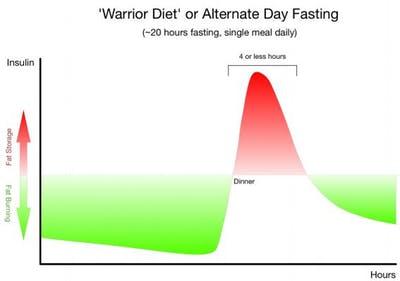
Eat Stop Eat
Eat stop eat, as popularized by bodybuilder Brad Pilon, involves fasting for an entire 24 hours, two days per week. Let’s say you eat your last meal of the day at 8:00 p.m. the day before. You fast overnight and then all the following day, skipping breakfast and lunch, and then pushing dinner out to 8:00 p.m. (for a full 24 hours with no calories).
This is quite difficult and is only recommended two days per week (nonconsecutive). While this is quite difficult, by the end of the 24 hours you do reach a very deep level of lipolysis and fat oxidation, with very low insulin levels, and this is quite desirable. Many people think that the following day they will binge on so much food that the benefits of the fasting on the previous day will be negated, but this is not true.
Studies have repeatedly shown that persons will overeat by hundreds of calories the next day, but still not come anywhere close to eating as much as they would have by eating normally both days (in other words, you are still left with a large net caloric deficit even after eating more food the day after your fast).
Each day that you fast in this fashion adds 12 hours of fasting compared to the standard 12:12 split we are calling baseline, and two days per week of this again equals about 24 hours of total additional fasting per week. [12 hours fasting per day times 2 days per week = 24 hours]
Coffee = Awesome
During the fasts feel free to drink ANY noncaloric beverage you want, including but not limited to: water, coffee (with or without noncaloric sweetener such as stevia), tea (hot or iced, sweetened with stevia if desired), diet soda with no calories, or any other beverage with no calories. However we would NOT recommend any calories AT ALL, as it takes frightfully few calories to spike insulin and sabotage your fast. Fat is the macronutrient that spikes insulin the very least, which is why so many people are using Bulletproof coffee or some other method of adding fat (butter, coconut oil, etc) to coffee in the morning.
However, we would NOT recommend this or any other source of calories while fasting, as this will be detrimental to what you are trying to accomplish with fasting. If you will absolutely die without at least a tiny splash of cream in your coffee well then do it, you will be better off with it than if this prohibition against cream in your coffee keeps you from trying to fast intermittently at all (95% fasting much better than 0% fasting)!
However we would try to keep the cream in your coffee to an absolute MINIMUM quantity, and you should also use this opportunity to learn to drink coffee black (this is something anyone can learn over time, believe it or not). We *HIGHLY* recommend the use of black coffee or tea in the morning to make your fast easier and more enjoyable. Both coffee and tea have numerous health benefits, and they both contain compounds that help with fat burning, energy, and alertness.
Visual Guide To Carbohydrates In Food
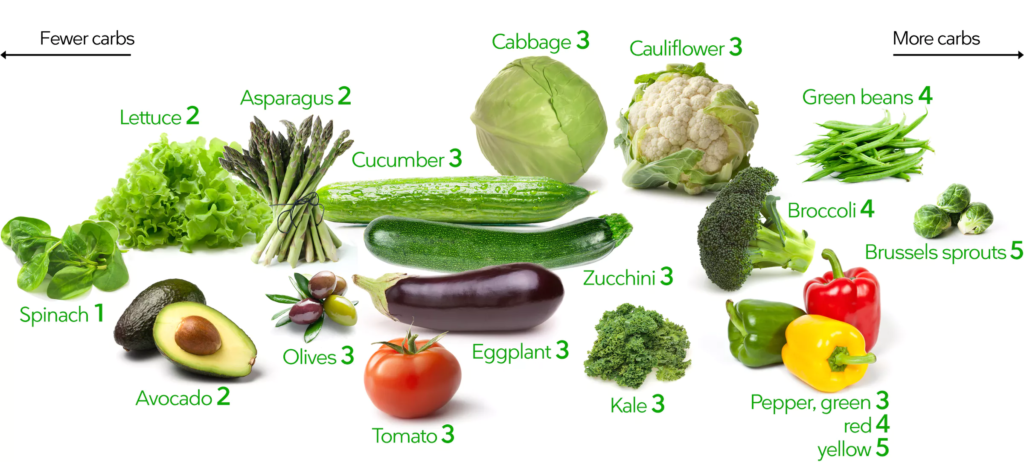

Note the difference between above-ground and below-ground vegetables. Vegetables with less than 5 percent carbs may be eaten relatively freely. If you’re on a not-too-strict low-carb diet (more than 20 grams per day), you can probably eat all you want of all these low-carb vegetables.
If you’re on a keto low-carb diet (below 20 grams a day), you may need to be a bit careful with some of the vegetables. You should probably be especially careful with bell peppers or tomatoes – these carbs quickly add up towards the 20 grams-a-day limit. Just one medium-sized bell pepper may contain 4-7 grams of digestible carbs.
Berries
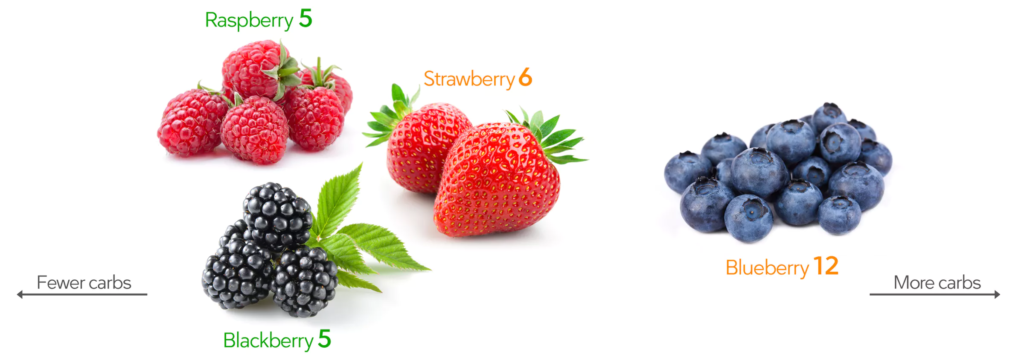
Fruits
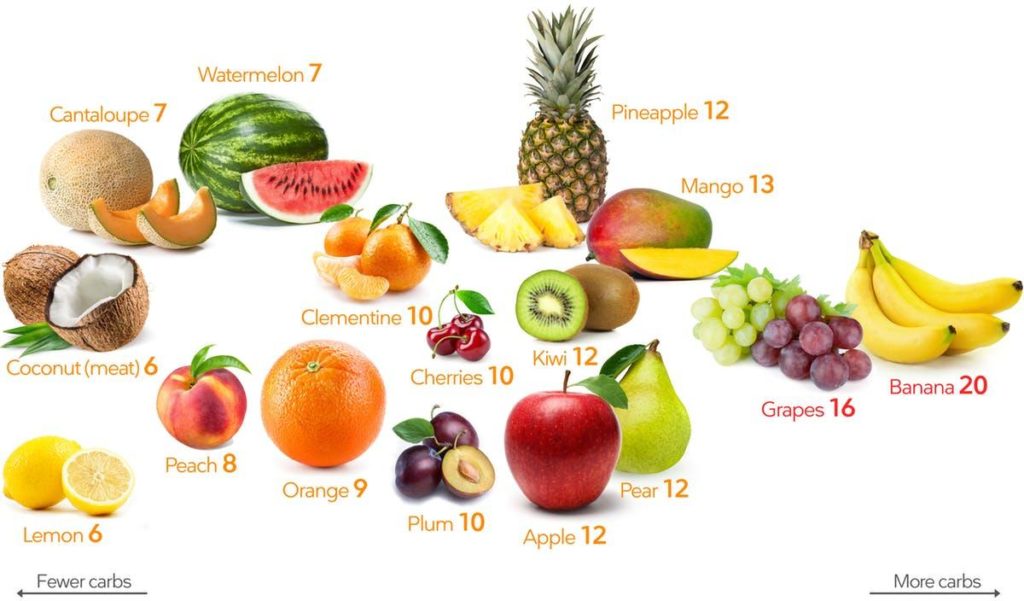
How Much Fruit Can You Have?
This means that on a keto low-carb diet (<20 grams per day) you’re probably better off having some berries instead. You don’t actually need to eat fruit. You can get any nutrient in fruit from vegetables – without all the sugar. Therefore, perhaps you want to try eating plenty of low-carb vegetables instead.
Even on a more moderate low-carb diet (20-50 grams per day) you’ll have to be careful with fruit – probably no more than about one a day.
On a liberal low-carb diet (50-100 grams per day) you may be able to squeeze in two or three fruits a day, if that is your biggest source of carbs.
As you see, grapes and bananas are the highest-carb fruits of them all.
Nuts
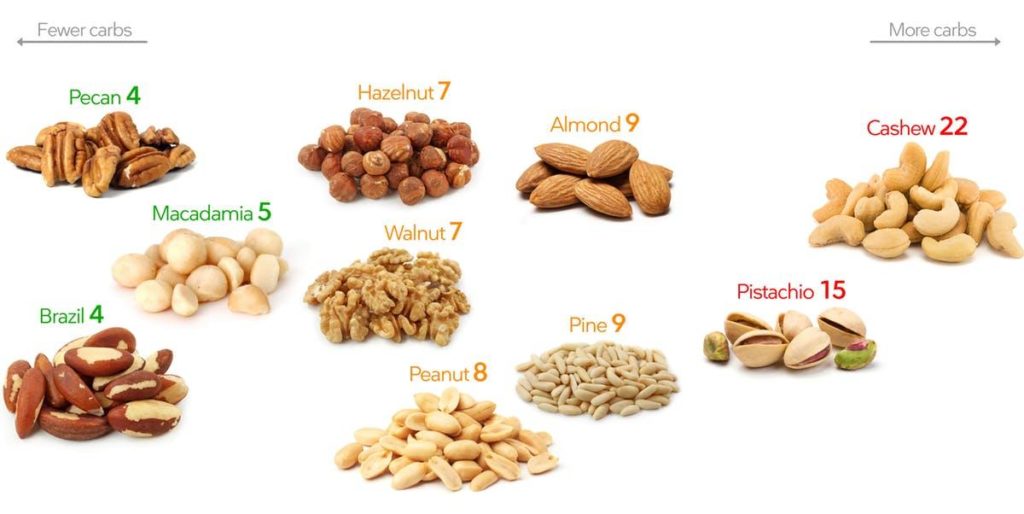
The numbers below the nuts are the percent of digestible carbohydrates, i.e net carbs. This means that a hundred grams of nuts (3½ ounces or about three handfuls) will contain this many net carbs.
No preparation needed
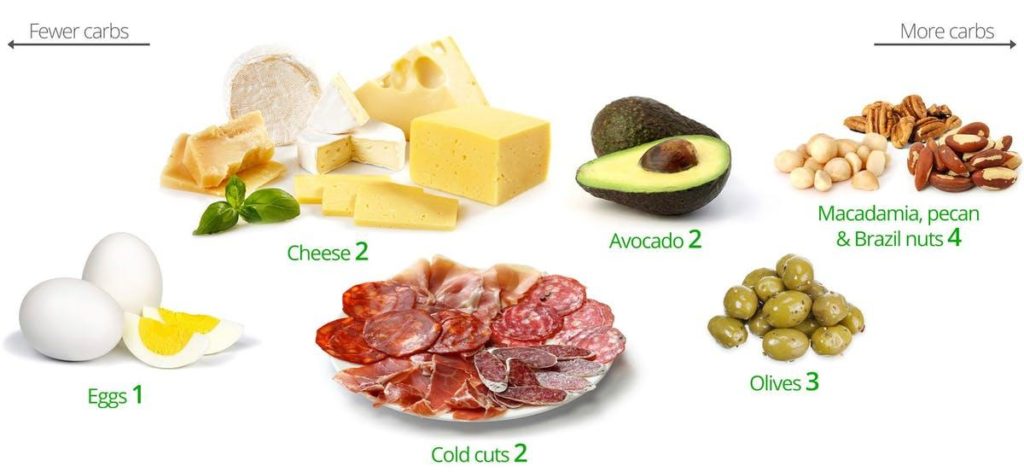
How many carbs in adult beverages?
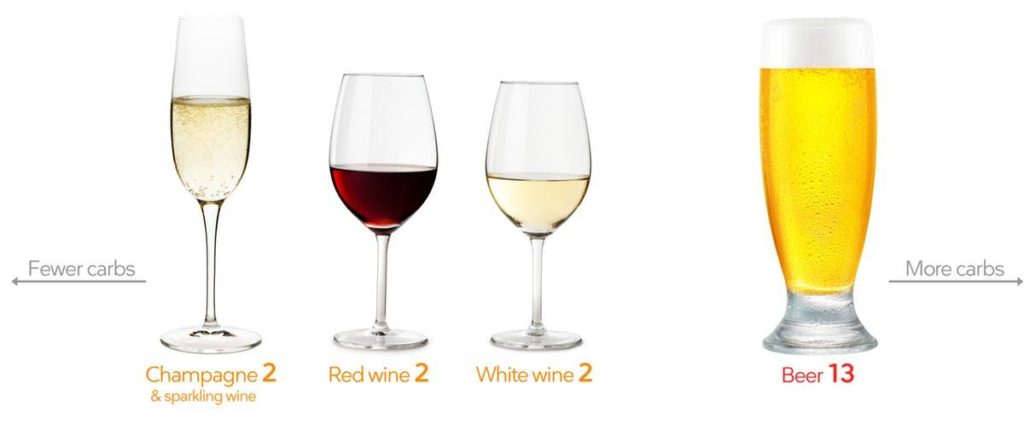
Beer: how many carbs?
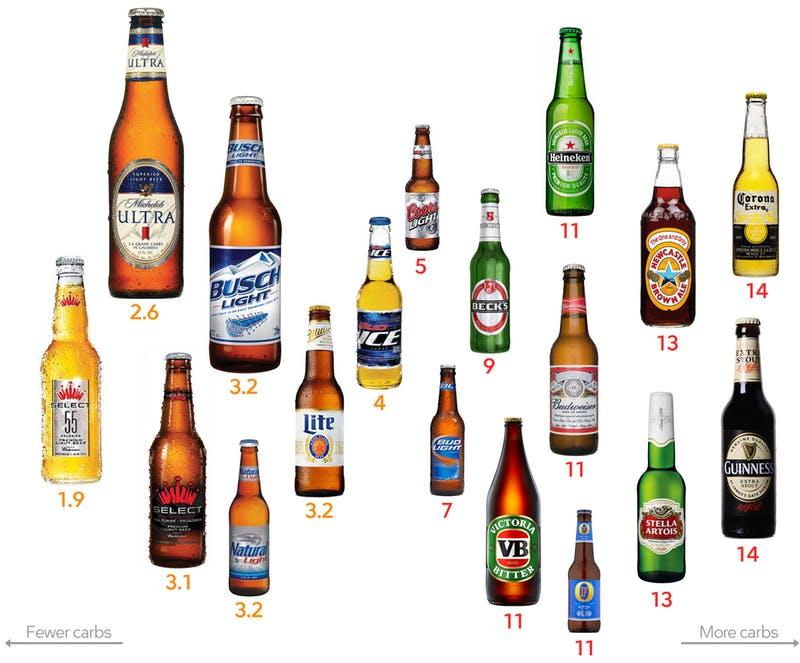
Spirits: how many carbs?
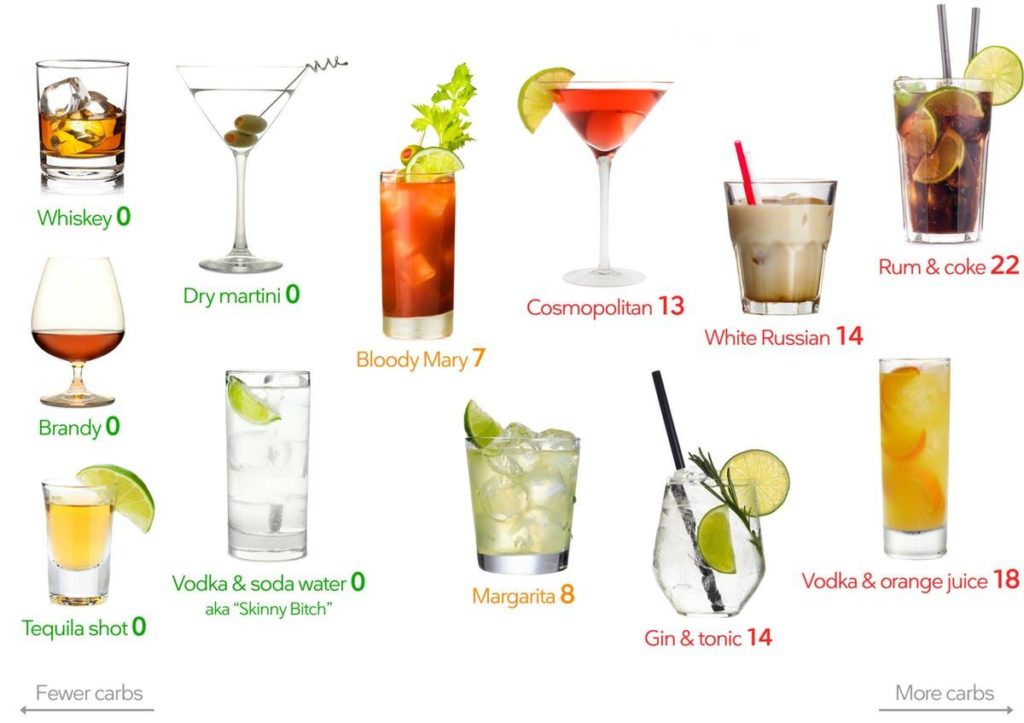
Top 5 low-carb alcoholic drinks
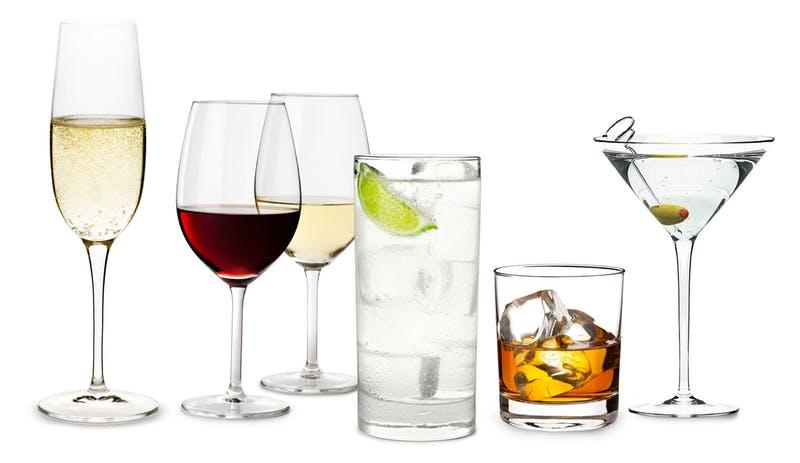
- Champagne or sparkling wine (extra dry or brut) – one glass contains about 2 grams net
- Dry wine – red or white – one glass contains about 2 grams of net carbs.
- “Skinny Bitch” – vodka, soda, lime and ice – one long drink contains 0 grams of carbs.
- Whiskey – one drink contains 0 grams of carbs.
- Dry Martini – one cocktail contains 0 grams of carbs.
Does drinking alcohol slow down weight loss on low carb?
Yes. The alcohol is burned first in the liver, slowing fat burning somewhat. Alcohol thus slows down weight loss. Furthermore, drinking alcohol can remove inhibitions, and this can result in eating things you were not planning to or needing to eat. If that happens it further slows weight loss. For effective weight loss, consume alcohol in moderation (choosing lower-carb options) or not at all.
Can you get a worse hangover on low carb?
Yes. Many people find that their tolerance is reduced on low carb, and that they are more likely to get a hangover. To minimize it don’t over-consume alcohol, and make sure to drink enough water.
What are the best alcoholic drinks that are low in carbs?
The top low-carb drinks are wine (dry white or red), champagne and pure zero-carb spirits like whiskey, gin or vodka (avoid cocktails with sugar in them).
Summary of what to eat
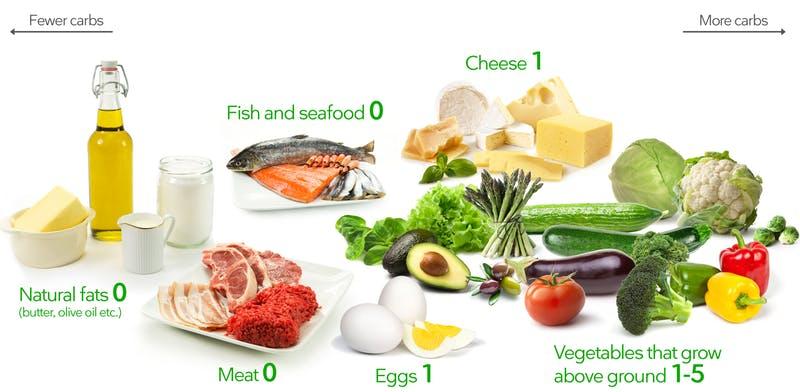
Drinks

In summary, eat real low-carb foods like meat, fish, eggs, vegetables and natural fats like butter or olive oil. As a basic beginner’s rule, stick to foods with fewer than 5% carbs (numbers above). Drink water, coffee, tea or the occasional glass of wine.
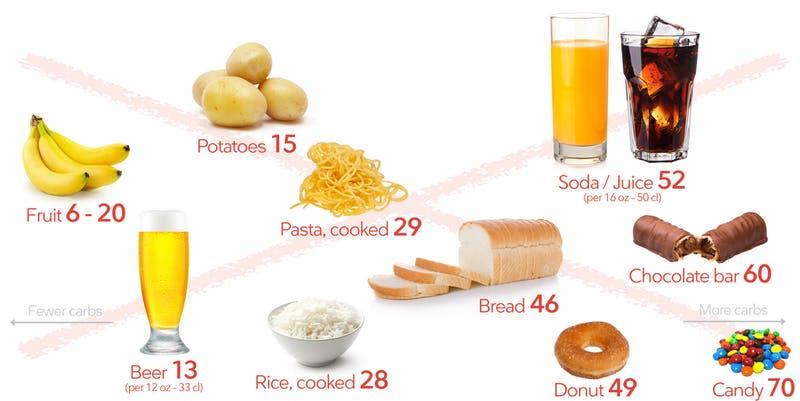
Here’s what you should not eat on a keto diet – foods full of sugar and starch. As you can see, these foods are much higher in carbs.

Douglas Miller, M.D.
Dr. Miller is a board-certified physician with training in
Internal Medicine, Emergency Medicine and
Advanced Bioidentical Hormone Replacement Therapy.

